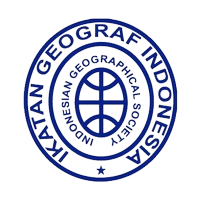PREDIKSI PERUBAHAN TUTUPAN LAHAN DI KECAMATAN SIRIMAU, KOTA AMBON MENGGUNAKAN CELULAR AUTOMATA- MARKOV CHAIN
Keywords:
Cellular Automata, Markov Chains, Tutupan Lahan, Kecamatan SirimauAbstract
Kecamatan Sirimau memiliki jumlah penduduk terbanyak di Kota Ambon yang berdampak pada kebutuhan terhadap lahan permukiman yang semakin tinggi meningkat, hal ini tentu akan mempengaruhi perubahan tutupan lahan yang tidak terkendali serta berdampak pada alih fungsi lahan dan kerusakan lingkungan. Penelitian ini bertujuan untuk untuk menganalisis perubahan tutupan lahan Kecamatan Sirimau pada tahun 2012, 2017 dan 2022, serta memprediksi tutupan lahan tahun 2031. Penelitian ini menggunakan metode Cellular Automata Markov Chains (CA-MC). Hasil penelitian menunjukan bahwa pada periode 2012-2031 luasan jenis tutupan lahan permukiman dan lahan terbuka terus bertambah seiring dengan bertambahnya jumlah penduduk dan tingginya kebutuhan akan lahan terbangun. Berbeda dengan tutupan lahan daerah pertanian dan bukan daerah pertanian yang mengalami penurunan luasan. Hasil penelitian diharapkan dapat dijadikan dasar dalam pengambilan kebijakan terkait penataan dan pemanfaatan ruang yang baik kedepannya
References
Badan Standarisasi Nasional. (2010). SNI 7645-2010 tentang klasifikasi penutup lahan.
Balist, J., Malekmohammadi, B., Jafari, H. R., Nohegar, A., & Geneletti, D. (2021). Detecting land use and climate impacts on water yield ecosystem service in arid and semi-arid areas. A study in Sirvan River Basin-Iran. Applied Water Science, 12(1), 4.
BPS. (2021). Kota Ambon Dalam Angka 2021 (BPS Kota Ambon (ed.)). BPS Kota Ambon.
Ghosh, P., Mukhopadhyay, A., Chanda, A., Mondal, P., Akhand, A., Mukherjee, S., Nayak, S. K., Ghosh, S., Mitra, D., Ghosh, T., & Hazra, S. (2017). Application of Cellular automata and Markov-chain model in geospatial environmental modeling- A review. Remote Sensing Applications: Society and Environment, 5, 64–77.
He, Q., He, W., Song, Y., Wu, J., Yin, C., & Mou, Y. (2018). The impact of urban growth patterns on urban vitality in newly built-up areas based on an association rules analysis using geographical ‘big data.’ Land Use Policy, 78(July), 726–738.
Irawan, I. A., Supriatna, S., Manessa, M. D. M., & Ristya, Y. (2019). Prediction Model of Land Cover Changes using the Cellular Automata – Markov Chain Affected by the BOCIMI Toll Road in Sukabumi Regency. KnE Engineering, 4(3 SE-Articles).
Islam, K., Rahman, M. F., & Jashimuddin, M. (2018). Modeling land use change using Cellular Automata and Artificial Neural Network: The case of Chunati Wildlife Sanctuary, Bangladesh. Ecological Indicators, 88, 439–453.
Laka, B. M., Sideng, U., & Amal, A. (2017). Perubahan Penggunaan Lahan di Kecamatan Sirimau Kota Ambon. Jurnal Geocelebes, 1(2), 43–52.
Lisanyoto, L., Supriatna, & Sumadio, W. (2019). Spatial Model of Settlement Expansion and its Suitability to the Landscapes in Singkawang City, West Kalimantan Province. {IOP} Conference Series: Earth and Environmental Science, 338, 12034.
Liu, Y. (2020). Sustainable Development in Urban Areas: Contributions from Generalized Trade. Sustainable Cities and Society, 61, 102312.
Mallick, S. K. (2021). Prediction-Adaptation-Resilience (PAR) approach- A new pathway towards future resilience and sustainable development of urban landscape. Geography and Sustainability, 2(2), 127–133.
Marko, K., Zulkarnain, F., & Kusratmoko, E. (2016). Coupling of Markov chains and cellular automata spatial models to predict land cover changes (case study: upper Ci Leungsi catchment area). IOP Conference Series: Earth and Environmental Science, 47, 012032.
Mohamed, A., & Worku, H. (2019). Quantification of the land use/land cover dynamics and the degree of urban growth goodness for sustainable urban land use planning in Addis Ababa and the surrounding Oromia special zone. Journal of Urban Management, 8(1), 145–158.
Mwabumba, M., Yadav, B. K., Rwiza, M. J., Larbi, I., & Twisa, S. (2022). Analysis of land use and land-cover pattern to monitor dynamics of Ngorongoro world heritage site (Tanzania) using hybrid cellular automata-Markov model. Current Research in Environmental Sustainability, 4, 100126.
Novia Utami, N. D., Supriatna, & Anggrahita, H. (2019). Spatial Dynamics Model of Land Availability and Mount Merapi Disaster-Prone Areas in Sleman Regency, Yogyakarta Special Region Province. IOP Conference Series: Earth and Environmental Science, 311(1), 012021.
Peter, A., Zachariah, B., Damuut, L. P., & Abdulkadir, S. (2021). Efficient Traffic Control System Using Fuzzy Logic with Priority (pp. 660–674). https://doi.org/10.1007/978-3-030-69143-1_50
Pratami, M., Susiloningtyas, D., & Supriatna. (2019). Modelling cellular automata for the development of settlement area Bengkulu City. IOP Conference Series: Earth and Environmental Science, 311(1), 12073.
Putri, R. A., & Supriatna, S. (2021). Land cover change modeling to identify critical land in the Ciletuh Geopark tourism area, Palabuhanratu, Sukabumi Regency. IOP Conference Series: Earth and Environmental Science, 623, 012081.
Rienow, A., Kantakumar, L. N., Ghazaryan, G., Dröge-Rothaar, A., Sticksel, S., Trampnau, B., & Thonfeld, F. (2022). Modelling the spatial impact of regional planning and climate change prevention strategies on land consumption in the Rhine-Ruhr Metropolitan Area 2017–2030. Landscape and Urban Planning, 217, 104284.
Shang, C., & Wu, J. (2022). A legendary landscape in peril: Land use and land cover change and environmental impacts in the Wulagai River Basin, Inner Mongolia. Journal of Environmental Management, 301, 113816.
Sukojo, B.M ., Hidayat.M., & Santoso, R. (2017). Analisis Ketelitian Horizontal Orthorektifikasi Citra Pleiades Untuk Pembuatan Peta Dasar Rdtr Pesisir (Studi Kasus : Kecamatan Semampir, Kota Surabaya). GEOID, 12(2), 136–142.
Sun, X., Wu, J., Tang, H., & Yang, P. (2022). An urban hierarchy-based approach integrating ecosystem services into multiscale sustainable land use planning: The case of China. Resources, Conservation and Recycling, 178, 106097.
Supriatna, Supriatna, J., Koestoer, R. H., & Takarina, N. D. (2016). Spatial Dynamics Model for Sustainability Landscape in Cimandiri Estuary, West Java, Indonesia. Procedia - Social and Behavioral Sciences, 227(November 2015), 19–30.
Talukdar, S., Eibek, K. U., Akhter, S., Ziaul, S., Towfiqul Islam, A. R. M., & Mallick, J. (2021). Modeling fragmentation probability of land-use and land-cover using the bagging, random forest and random subspace in the Teesta River Basin, Bangladesh. Ecological Indicators, 126, 107612.
Tan, S., Liu, Q., & Han, S. (2022). Spatial-temporal evolution of coupling relationship between land development intensity and resources environment carrying capacity in China. Journal of Environmental Management, 301, 113778.
Tian, G., Ma, B., Xu, X., Liu, X., Xu, L., Liu, X., Xiao, L., & Kong, L. (2016). Simulation of urban expansion and encroachment using cellular automata and multi-agent system model—A case study of Tianjin metropolitan region, China. Ecological Indicators, 70, 439–450.
Villarreal-Rosas, J., Wells, J. A., Sonter, L. J., Possingham, H. P., & Rhodes, J. R. (2022). The impacts of land use change on flood protection services among multiple beneficiaries. Science of The Total Environment, 806, 150577.
Wulandari, R., Supriatna, & Latif Indra, T. (2019). A simulation model for urban development in Bandar Lampung City, Lampung, Indonesia. IOP Conference Series: Earth and Environmental Science, 248, 012090.
Zadeh, L. A. (1994). Fuzzy logic, neural networks, and soft computing. Communications of the ACM, 37(3), 77–84.
Zheng, Q., Weng, Q., & Wang, K. (2021). Characterizing urban land changes of 30 global megacities using nighttime light time series stacks. ISPRS Journal of Photogrammetry and Remote Sensing, 173, 10–23.
Downloads
Published
Issue
Section
License
Copyright (c) 2023 JURNAL SWARNABHUMI : Jurnal Geografi dan Pembelajaran Geografi

This work is licensed under a Creative Commons Attribution-ShareAlike 4.0 International License.

Jurnal Swarnabhumi : Jurnal Geografi dan Pembelajaran Geografi by http://www.univpgri-palembang.ac.id/e_jurnal/index.php/swarna is licensed under a Creative Commons Attribution-ShareAlike 4.0 International License.











